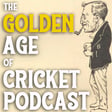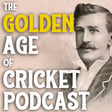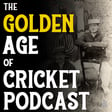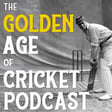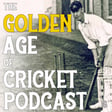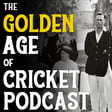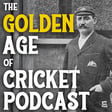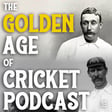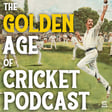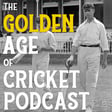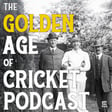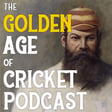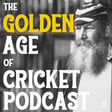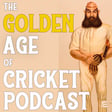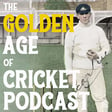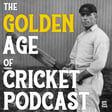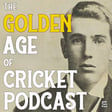Introduction to Cricket's Golden Age
00:00:07
Speaker
Hello and welcome to the first in a series of short episodes reliving the details of significant matches, innings or moments from the so-called Golden Age of Cricket. Thanks for joining, my name is Tom Ford.
Origins of the Golden Age
00:00:21
Speaker
While it is generally considered that the Golden Age began at some point in the early 1890s, an exact starting point is complete conjecture.
00:00:30
Speaker
After a decade or so of administrative overtures, player revolts and riots, and a cavalcade of relatively uncompetitive and uninspiring international fixtures, the new decade brought forth a new generation of cricketers, with a couple of old stages still in the midst too.
00:00:47
Speaker
In 1890, the county championship in England was finally formalised through a point system after more than a century of ad hoc county fixtures. And the following year while on tour in Australia, Lord Sheffield donated a sum of money which resulted in the Sheffield Shield, similarly giving the Australian first class season a framework.
The 1894-95 Ashes Series
00:01:07
Speaker
But if we want to talk about international test series which best encapsulated the new era, both locally and abroad, and set the ashes rivalry in permanent concrete, it's hard to look past the 1894-95 series in Australia which contains some of the greatest and most riveting matches of all time.
00:01:27
Speaker
The previous tour of Australia by an England team was led by the great but aging W.G. Grace across the summer of 1891-92, and while many combative matches unfolded, the headlines surrounding Grace's exorbitant tour fees and his so-called shamaturism were the focus, and like his only other Australian tour of 1873-74, left the antipodes failing to promote the gentleman's game for the mother country and empire as was routinely promised.
00:01:57
Speaker
The follow-up Ashes Tour in England in 1893 was a rather dull, rain-affected affair in which the home team won the three-match series 1-0. But the 1894-95 series proved a turning point in the whole Ashes saga, from which the rivalry never looked back. It was a new era with numerous players making their international debuts, many of whom would become household names over the next decade or so.
Leadership Changes and Team Dynamics
00:02:23
Speaker
It was the first series, too, in which five matches were played, all of which saw a result, too. Lord Sheffield, the patron of the 91-92 England touring party, declined an invitation to again make the arduous voyage to the southern hemisphere. W.G. Grace was also not in a position to tour again, and so the Australian organisers approached Andrew Stoddart, an England and Middlesex batsman, and asked him to lead the touring party.
00:02:52
Speaker
Stoddart was acknowledged as one of the leading players in England and had also, in 1888, captained the country in rugby. When Grace injured a finger before the Lord's test in 1893, Stoddart therefore became the first and only person to lead both the England cricket and rugby sides.
00:03:11
Speaker
The team that joined him was a squad heavy in professionals with only a handful of amateurs. The English press back home were buoyant of the team's chances, especially considering the talented batting line-up, which included Captain Stoddart, Archie McLaren, Jack Brown, Albert Ward, bowlers Tom Richardson, Johnny Briggs, Bill Lockwood and all-rounders Bill Brockwell and Bobby Peel. The Australian side too was considered strong and the local press favoured its chances against the visitors.
00:03:40
Speaker
Captained by the Prince of Wicked Keepers Jack Blackham, although he would withdraw from the series following an injury in the first test, he was the last remaining player from the first ever test match in March of 1877.
00:03:53
Speaker
Incidentally one of the umpires for this match was Charles Bannerman, Blackham's teammate from that first tests match 18 years before. Bannerman faced the first ball, hit the first run and first century in test cricket. This team however was anchored by the great all-rounder and the WG of the Antipodes George Giffen. He was flanked in the lineup by fellow South Australian batsman Jack Lyons,
00:04:18
Speaker
Johnny Reedman and debutante Joe Darling, as well as other strong batsmen Sid Gregory and Harry Trott, and opening bowlers Charlie Turner and Ernie Jones.
England's Warm-Up Matches in Australia
00:04:28
Speaker
Each side favoured its chances, and the first test was slated to begin on the 14th of December 1894 at the newly renamed Sydney Cricket Ground, formerly known as the Association Cricket Ground.
00:04:42
Speaker
In the lead-up to the first test, Stoddart's side had played a number of warm-up matches against the colonies. The English cricketers docked at Largs Bay, South Australia on Tuesday 30th October, onboard the ship the Ophir, a journey of six weeks, and set about practising the very next day.
00:05:00
Speaker
The team's first match was against South Australia at the Adelaide Oval in November. George Giffen underlined his all-round genius, becoming the first player to either score 50 or take five wickets in all four innings of a first-class match.
00:05:16
Speaker
South Australia beat a touring English side for the very first time, winning by six wickets, largely on the back of a brilliant 117 from young Joe Darling, which ultimately secured his place in the test side the following month. Brockwell was the only other centurion in the match, scoring 115 for the visitors.
00:05:36
Speaker
Stoddart's English 11 then played against Victoria at the Melbourne Cricket Ground just two days after the conclusion of the match against South Australia, and they beat the locals by 145 runs, thanks to a blistering double century from opener Archie McLaren, who was on his first of many tours to Australia.
00:05:55
Speaker
The England team then travelled to Sydney for the third warm-up match, before the first test, facing a young New South Wales team, with future test stars for Australia Howe, Kelly and McKibben all making their debuts for the colony. Storart's team won again, this time by eight wickets, with Jack Brown scoring his first century on tour, as he contributed more than 800 first class runs for the whole Australian summer.
First Test Begins at Sydney
00:06:22
Speaker
Finally, Storart's English 11 played its last match before the tests against a weak Queensland side in Brisbane. This was three decades before Queensland entered the Sheffield Shield and their first-class competitiveness was still a work in progress.
00:06:37
Speaker
The English won the match by an innings, with centuries to Albert Ward and Captain Stoddart. An opening fast bowler, Tom Richardson, took 11 wickets for the match, to leave the English tourists with much confidence, leading into the opening test four days later.
00:06:52
Speaker
The first test in Sydney was a momentous occasion regardless of the ultimate result. Previously known as the Association Cricket Ground, this was to be the first test under the official name of the Sydney Cricket Ground, and a flag-bearing SCG flew above the pavilion to underline this fact.
00:07:12
Speaker
Captain Stoddart and Blackham met to toss the coin on the opening morning of the 14th of December, with Stoddart remarking, one of us will be swearing soon, Jack. I hope it's you. However, the home captain won and elected to bat in front of a local crowd nearing 11,000.
00:07:30
Speaker
Opening pair Jack Lyons and Harry Trott walked to the centre and took guard against England's express bowler Tom Richardson of Surrey. The first ball came shortly after midday and within 10 minutes Richardson had made the breakthrough, playing bowling Lyons for one run. Shortly after, Richardson broke through again, dismissing the other opener Trott for 12 runs in an almost identical manner, uprooting his off stump with a near unplayable delivery. Australia were 2 for 21.
00:08:00
Speaker
debutante Joe Darling then appeared at the wicket to face the Richardson music. Darling was to lead three Australian tours to England in 1899, 1902 and 1905. However, if this innings in 1894 was to foreshadow his great career, Richardson had other ideas. With the first ball, the fast Surrey bowler sent down a lightning-quick yorker and had Darling's middle and off stumps rattled. Australia now three for 21 and Darling out for a golden duck in his first match.
Australia's Strong Comeback
00:08:31
Speaker
With Australia losing three early wickets, George Giffen and Frank Iredow steadied the ship, seeing Richardson off and managing against Peel, Briggs and Lockwood to reach lunch at 3 for 78. After lunch, Richardson returned to the crease, but Giffen and Iredow now had their eyes in and looked set.
00:08:49
Speaker
Their fourth wicket partnership reached 171 before Iredow was caught by Captain Stoddard off the bowling of Francis Ford for 81. The score was 4 for 192 at T.
00:09:03
Speaker
Adding to England's concerns with Bill Lockwood having to leave the field with a shoulder injury following a fielding attempt. In what seems ridiculous to modern ears, but was a common occurrence in 19th century cricket, Australia's Charlie Turner replaced Lockwood in the field for England.
00:09:20
Speaker
Giffen, who continued to pummel the English bowling attack, was joined by the young Sid Gregory, a local New South Welshman who had actually been born in the sheds out the back of the ground in 1870, as his father was the long time curator of the cricket venue.
00:09:36
Speaker
Together, Giffen and Gregory undid England's excellent first session by tiring out the bowlers at both ends. Having been dropped on 90 by wiki keeper Leslie Gay, Giffen hit Richardson off his pads to the leg side boundary to reach his only test century. For a giant of the game, perhaps a little surprising that Giffen only hit a solitary test hundred, but his first-class record, during an age when such things carried weight, is almost unsurpassed in Australia.
00:10:06
Speaker
Giffen and Gregory took the total to 331 when Giffen nicked a ball from four just 10 minutes before stumps. He had hit 161 in four and a half hours. His innings included 22 fours and a five. Five being the score one received for hitting what today would be classified as a six. To receive a six in 1894, one had to literally hit the ball out of the ground.
00:10:34
Speaker
New batsman Reedman helped Gregory see through to stumps and Australia would have been happy with their recovery, from 3 for 21 to 5 for 346, with Gregory not out on 85. Dropped catches, including a number from the keeper, compounding England's frustration.
00:10:51
Speaker
Following Australia's strong recovery late on the first day, day two of the test saw a huge crowd arrive to watch the match, almost 25,000 paying supporters. This was significant for 1894, considering Sydney's population at the time had yet reached half a million citizens. Sid Gregory and Jack Reidman resumed their partnership and resisted Richardson's re-energised deliveries.
00:11:16
Speaker
Lockwood was still injured and so much of the burden fell on Richardson's shoulders, ably supported by Bobby Peel. Gregory notched his sentry up with a fine cut shot and there was much cheering from the locals. Reedman resisted some fiery short balls from Richardson before looping one to forward off Peel. McLeod and Turner came and went pretty quickly soon after to have Australia at 8 for 409.
00:11:42
Speaker
captain and wicket keeper Jack Blackham strode to the wicket to join Gregory. Unbeknownst to the crowd or Blackham himself, this would be his 35th and final test match. The English players must have thought they'd soon be padding up when the 40-year-old Blackham came to the crease, but to the delight of the Australian crowd Blackham and the in-form Gregory began carting the tired English boulders to all areas of the field.
00:12:09
Speaker
Both Richardson and Peel bowled more than 55 overs in this Australian innings, an incredible workload by modern standards. The ninth wicket partnership between Gregory and Blackham of 154 stood for over 100 years, and they wasted no time in notching the runs, generating them at two runs a minute.
00:12:29
Speaker
They took the total pass 500, the first time Australia had done this in a home test. Gregory continued to break records, surpassing the 165 Charles Bannerman scored in the inaugural test to own the highest test score on home soil. As he was umpiring this match, we can only guess whether Gregory and Bannerman discussed this record.
00:12:52
Speaker
Gregory battered on and on until he eventually reached his double century. According to local papers, a five minute standing ovation was given. In the early days of test cricket, such huge individual scores were monumental occasions. He was eventually out for 201, falling 10 runs short of Billy Murdoch's highest ever test score of 211 against England at the Oval in 1884.
00:13:20
Speaker
The Sydney Morning Herald reported, never such a cheer went up from the ground as greeted Gregory on his way back to the pavilion with 201 to his credit, and the cheering was renewed for round after round with fresh figure as he walked up the steps.
00:13:37
Speaker
The local Sydney crowd was so appreciative of Gregory's effort that they started a monetary collection. At the end of the day's play, New South Wales Premier and future fourth Prime Minister of Australia, George Reid, handed over £100 to the embarrassed but grateful Gregory. The funds included £25 from the trustees of the Sydney Cricket Ground, £5 from the Melbourne Cricket Club and £20 from the local brewer.
00:14:05
Speaker
Ernie Jones joined Blackham and whacked a few quick runs before Blackham was finally dismissed for 74. It was his highest test score in cricket. Australia finally dismissed in the final session of day two for the sizeable total of 586.
England's Challenging Start
00:14:21
Speaker
Tom Richardson had laboured for his 5 for 181.
00:14:26
Speaker
The England Openers Albert Ward and Archie McLaren walked out to begin their enormous climb to reach Australia's total as they faced the opening bowling pair of the young tearaway Ernie Jones and aging but still very effective Charlie Turner.
00:14:42
Speaker
McLaren, who had been in good form in the first-class lead-up matches, fell for just four off a quicker delivery from Turner as England limped out of the blocks to be one for 14. Captain Stoddart joined Ward and managed to steady their ships somewhat before also falling cheaply for 12 runs. His offender, George Giffen. Fresh from his 161 in the Australian innings and his all-round effort against Stoddart's 11 in Adelaide the previous month,
00:15:10
Speaker
Blackham had wasted little time bringing his star all-rounder on to unsettle the English batsmen. England 2 for 43 as the end of the second day drew near. Jack Brown of Yorkshire making his test debut reached a nervously made 22 before running himself out after choosing to run on a Jack Lyons misfield.
00:15:32
Speaker
Albert Ward and Bill Brockwell then saw England as stumps, glad to have survived as England were three down and still 456 runs in arrears.
Conclusion and Tease for Next Episode
00:15:42
Speaker
As the players left the field, black clouds gathered above, an ominous sign for the rest of the match.
00:15:50
Speaker
Thanks for listening to part one of this short leg episode on the famous Sydney Test match of 1894. I'll return shortly with part two, so do keep an eye out. I'm Tom Ford. Thanks for listening.

